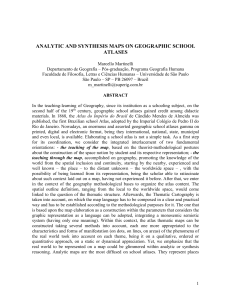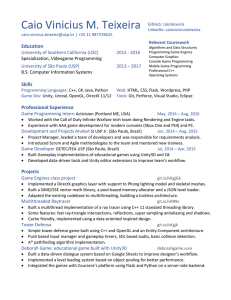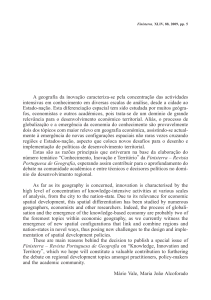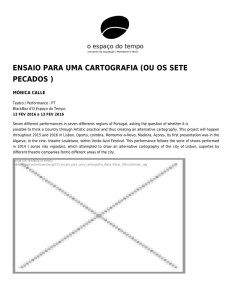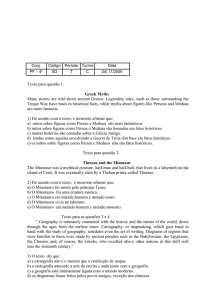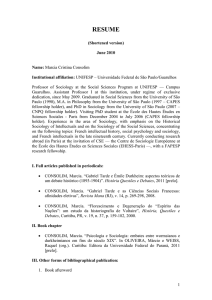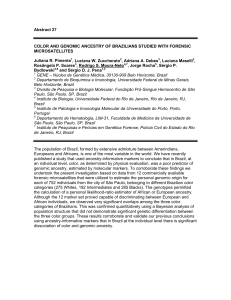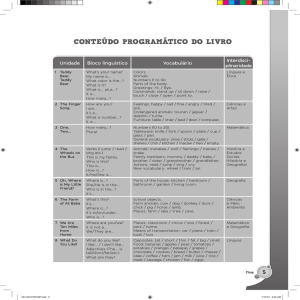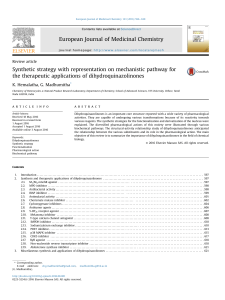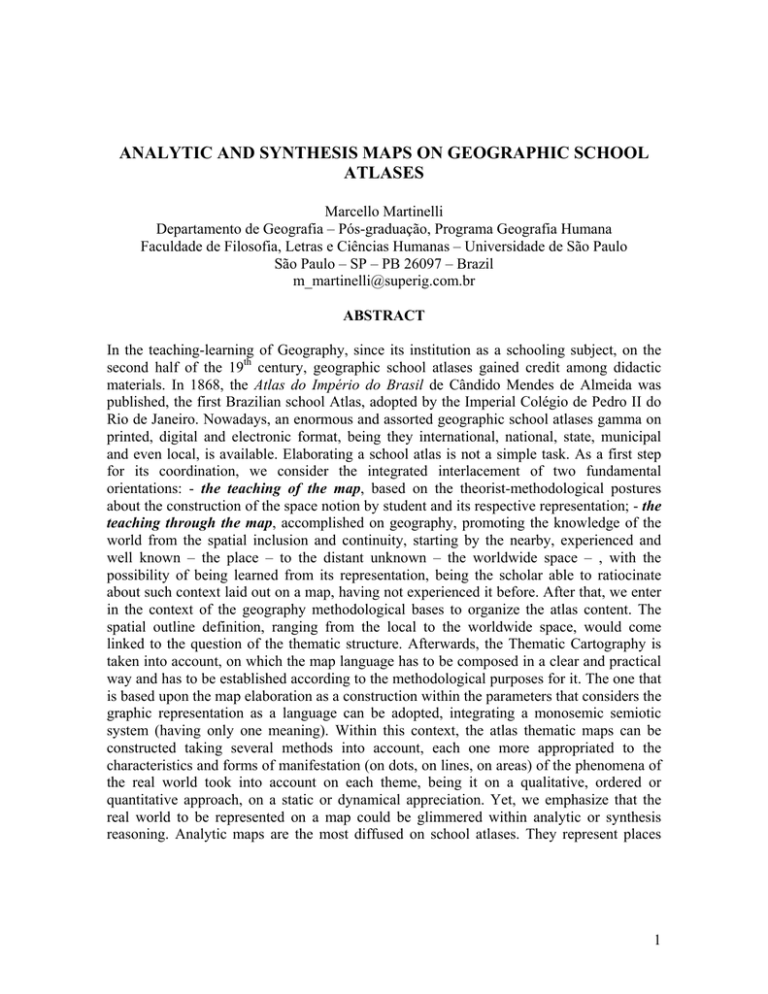
ANALYTIC AND SYNTHESIS MAPS ON GEOGRAPHIC SCHOOL
ATLASES
Marcello Martinelli
Departamento de Geografia – Pós-graduação, Programa Geografia Humana
Faculdade de Filosofia, Letras e Ciências Humanas – Universidade de São Paulo
São Paulo – SP – PB 26097 – Brazil
[email protected]
ABSTRACT
In the teaching-learning of Geography, since its institution as a schooling subject, on the
second half of the 19th century, geographic school atlases gained credit among didactic
materials. In 1868, the Atlas do Império do Brasil de Cândido Mendes de Almeida was
published, the first Brazilian school Atlas, adopted by the Imperial Colégio de Pedro II do
Rio de Janeiro. Nowadays, an enormous and assorted geographic school atlases gamma on
printed, digital and electronic format, being they international, national, state, municipal
and even local, is available. Elaborating a school atlas is not a simple task. As a first step
for its coordination, we consider the integrated interlacement of two fundamental
orientations: - the teaching of the map, based on the theorist-methodological postures
about the construction of the space notion by student and its respective representation; - the
teaching through the map, accomplished on geography, promoting the knowledge of the
world from the spatial inclusion and continuity, starting by the nearby, experienced and
well known – the place – to the distant unknown – the worldwide space – , with the
possibility of being learned from its representation, being the scholar able to ratiocinate
about such context laid out on a map, having not experienced it before. After that, we enter
in the context of the geography methodological bases to organize the atlas content. The
spatial outline definition, ranging from the local to the worldwide space, would come
linked to the question of the thematic structure. Afterwards, the Thematic Cartography is
taken into account, on which the map language has to be composed in a clear and practical
way and has to be established according to the methodological purposes for it. The one that
is based upon the map elaboration as a construction within the parameters that considers the
graphic representation as a language can be adopted, integrating a monosemic semiotic
system (having only one meaning). Within this context, the atlas thematic maps can be
constructed taking several methods into account, each one more appropriated to the
characteristics and forms of manifestation (on dots, on lines, on areas) of the phenomena of
the real world took into account on each theme, being it on a qualitative, ordered or
quantitative approach, on a static or dynamical appreciation. Yet, we emphasize that the
real world to be represented on a map could be glimmered within analytic or synthesis
reasoning. Analytic maps are the most diffused on school atlases. They represent places
1
characterized for attributes or variables. Involve a reasoning directed to the analysis of the
geographic space, mobilizing proceedings of classification, combination and search of the
elucidations about facts or phenomena seen on maps, but not being able to suggest the
causality or to give explanations, but indicate new researches. Synthesis maps would not
show the elements on superposition or juxtaposition anymore, but their fusion in “types”.
This means they have to identify groupings of places being characterized by groupings of
attributes or variables. According to the purposes and stipulated fields of study, synthesis
cartography can be done through several methods that had been developed along the search
of such accomplishment. Basically two main groups can be pondered: graphic methods and
statistic-mathematic methods. Among the graphic methods we consider: Tri-chromatic
superposition, Cartographic method, Graphic matrix’s method and Triangular graph
method. In Tri-chromatic superposition, we would work on transparent maps of attributes
or variables, which will be superposed three by three, in the colours blue (cyan), yellow and
red (magenta). Spatial sets characterized by distinct combinations of the three components
are delimited in this coloured visualisation. In the Cartographic method, synthesis would be
done from analytic maps, in three steps: a) one map for each attribute or variable, solved in
a visual order; b) intermediary synthesis, suggesting a preliminary spatial grouping; c) final
synthesis with the delimitation of the “types” of space. In the Graphic matrix’s method,
synthesis would be obtained from a geographical data matrix. This table is transcribed into
a graphic form with visual proportionality of sizes. Rows, as well as columns, are
exchanged until the ones that are more similar get close, forming a second image, which
has to be interpreted, corresponding to the synthesis that will be plotted on the map. The
triangular graph method is employed for searching the “types” of ternary structures. The
different combinations of the three components of the studied variable are synthesized
trough dots within the triangle. Places are grouped according to the categories defined by
the particular position they occupy in the graph. Synthesis is what will be laid out on the
map. Synthesis cartography can also be worked on dynamical approaches like, types of
phenomena evolutions for a certain period of time. Synthesis through statistic-mathematic
methods will offer more objective results. For that, the adoption of Factor analysis methods
is customary, complemented by the Cluster analysis method. Factors are determinate. Each
factor represents a group of variables. With the Cluster analysis we get to the linkage tree.
Regarding it, a certain level of aggregation is stipulated on which an acceptable quotation
of minimal intra-groups variance and maximal inter-groups variance occurs. The
cartography of the groups means synthesis on map. For the statistic-mathematic procedures,
many specific programs were made available with the institution of informatics and, more
recently, also the participation of specific functions available on the Geographic
Information Systems. These methodological directions are considered imperative for the
idealization of geographic school atlases when involving analytic and synthesis maps. They
will confirm to them their pedagogic role in geography, assuring you that you will be
2
actively participating on the moulding of the citizen for the practice of social
transformation.
INTRODUCTION
In the teaching-learning environment of Geography, since its institution as a schooling
subject, on the second half of the 19th century, geographic school atlases gained credit
among didactic materials, increasingly adapting themselves to this task in the classroom.
They have appeared as selections and simplifications of the great general reference atlases,
which evolved from simple collections – easy ways of assembling maps –, to a systematic
organization with specific and intellectual purpose, securely crystallized by the capitalist
way of production, hegemonic from that period.
The “Atlas général Vidal-Lablache: histoire et géographie” of 1824, was a classic that
inspired several derivations in France as well as in other countries of the continent.
Almost thirty years before, in 1868, the first Brazilian school atlas was published, the Atlas
do Império do Brasil de Cândido Mendes de Almeida. It was adopted by the Imperial
Colégio de Pedro II do Rio de Janeiro.
Fruit of a whole evolution and epistemological transformation of atlases cartography and of
the affirmation of a market economy increasingly more globalized, nowadays an enormous
and assorted geographic school atlases gamma is available on printed, digital and electronic
format, being they international, national, regional, state, municipal and even local.
1. ATLASES METHODOLOGICAL BASE
Elaborating a school atlas is not a simple task. Neither simplifying maps, nor making them
more attractive, nor even selecting the easiest themes, is enough. These elements have to be
pondered, but they are not the essential ones. Such tradition persists neglecting a whole
specific methodological foundation. This will have to start, on one hand, from the
lucubration about the construction of the space notion by the student and its representation.
We would have as a main source, among others, the psychogenetic studies of Jean Piaget
and his team and of other pieces of work, like the ones from Vygotsky and Wallon, about
the relationships between the speech as a symbolic activity, the structure of time and the
construction of memory too (Piaget and Inhelder, 1972; Taille, 1992; Vygotsky, 1998).
3
In Brazil, we count on the contributions of Professor Doctor Lívia de Oliveira, who, in her
pos-doctor research and other studies that came next, established the master lines for a
correct orientation of these works, having instituted a proper school with high qualification
disciples (Oliveira, 1978).
To elaborate a school atlas, we make a premise, that it will not be only a collection of maps,
ready and finished, but a systematic organization of representations worked with a specific
intellectual purpose. With this intent, the articulation of two fundamental methodological
bases has to be taken into account: the methodological basis of the map and the
methodological basis of the acquisition of knowledge in geography trough the map.
Besides, the selected thematic representations have to be constructed from consistent data,
aiming to reveal the information content about the present, providing the student with the
comprehension of certain questions which are placed to him, in search of the understanding
of the real world around him (Wurman, 1989).
Therefore, maps would not be seen as they traditionally are, as mere illustrative figures of
didactic texts, but as representations that reveal questions that will be tackled and discussed
within the geographic speeches, opening space to a critical and conscious reflection.
For the atlas enterprise, we consider the integrated interlacement of two basic orientations
as a first step for its coordination:
- The teaching of the map, propagated on the theorist-methodological postures about the
construction of the space notion and its respective representation by the scholar, involving
initial cartography practices,
- The teaching through the map, accomplished on geography, promoting the knowledge of
the world from the spatial inclusion and continuity, starting by the nearby, experienced and
well known – the place – to the distant unknown – the worldwide space –, but with the
possibility of being learned from its representation, being the scholar able to ratiocinate
about such context laid out on a map, having not experienced it before.
After that, we enter the context of the geography methodological bases to organize the atlas
content.
The spatial outline definition, ranging from the local to the worldwide space, would come
linked to the question of the thematic structure.
4
Afterwards, the Thematic Cartography is taken into account; on which the map language
has to be composed in a clear and practical way; and has to be established according to the
methodological purposes for it. The one that is based upon the map elaboration as a
construction within the parameters that consider the graphic representation as a language
can be adopted, integrating a monosemic semiotic system (having only one meaning)
(Bertin, 1973).
Within this context, the atlas thematic maps can be constructed taking several methods into
account; each one more appropriated to the characteristics and forms of manifestation (on
dots, on lines, on areas) of the phenomena of the real world took into account on each
theme, being it on a qualitative, ordered or quantitative approach.
On representations, we can also undertake an appreciation under the static point of view,
constituting the static cartography, or dynamical, structuring the dynamical cartography.
Yet, we emphasize that the phenomena that compose the real world to be represented on a
map could be glimmered within analytic or synthesis reasoning. Thus, on one hand we have
analytic cartography, giving attention to the constitutive elements of the real world, the
places characterized by attributes or variables and, on the other hand, synthesis
cartography, identifying and delimiting integrated spatial units, which mean groupings of
places being characterized by groupings of attributes or variables.
2. ANALYTIC MAPS
Analytic maps are those that involve a reasoning directed to the scrutiny of the geographic
space, mobilizing procedures of classification, combination and search for explanations
about facts or phenomena seen indistinctly on the real world. These would be rational
constructions, whose structure would be expressed on the legend, organized as a logical
system. The mental operations undertaken, regarding analytic maps, will allow the student
to formulate conjectures about what would elucidate the phenomena geography. However,
before a more rigorous critic, we affirm that they would be not able to suggest the
causalities or to give the explanations by themselves, but indicate new researches (Rimbert,
1968; Claval e Wieber, 1969).
These authors also say that analytic maps show patterns, dominant directions, groupings,
constellations and shafts that reveal the information, of which we can take advantage. Yet,
it leads to many questions, and these are the ones that bit by bit will allow us to reach new
discoveries.
5
Analytic maps are the most diffused on school atlases. They can display representations on
a qualitative, ordered or quantitative approach, considering manifestations on dots, lines,
and areas, being they on a static or dynamical point of view.
Those qualitative express the existence, the location and the extension of the events on a
certain situation on the time, that are distinguished by their nature, species, allowing them
to be classified by criteria established by the sciences that study them. For example, themes
like Political organization, Hydrographical basins, Navigable rivers, Mineral resources,
Air-masses, Vegetation, Land use, Indigenous lands, Transport network, Airlines, Maritime
routes and Environment.
Ordinate maps show, on a certain date, categories that are enlisted on a sole sequence,
defining hierarchies, or focalize, on a single map, aspects that were being consolidated over
the time. Examples of the first ones are themes like Relief, Functional hierarchy of urban
centres, and of the second ones, the Geology.
Quantitative maps evidence the relationship of proportionality between quantities that
characterize places or areas for a certain moment. For example, themes like Rainfall,
Temperature, Winds, Population, Agricultural and cattle breeding production, Industrial
production and Tourist accommodation offer.
From a dynamical point of view, maps can show qualitative and quantitative variations on
the time or qualitative and quantitative directed movements on the space. For the
qualitative variations we quote the theme Retraction of native vegetation. Those
quantitative recall themes like Population growing rate, Migratory balance, Migratory
surplus and Foreign trade. For dynamical maps of qualitative movements, we evoke themes
like Atmospheric currents and Marine currents as examples. Of those quantitative ones,
Cash flows, Migratory flows, Tourist flows, Passengers flows, Flows of goods, Maritime
traffic and Aerial traffic are examples.
3. SYNTHESIS MAPS
To Claval and Wieber (1969: 103), synthesis maps would have, as their first function,
pointing out the correlations, evidencing connections between distinct phenomena.
They warn us that, when superposing many themes, we are not always able to show the
connections. Each theme would be lost in a confusion of symbols. So, they advise us to
superpose simplified thematic maps, on which spatial relationships would appear clearer.
However, synthesis is a necessity, but it has to be treated in a way that makes new
configurations to emerge, completely different from those resulted of a simple sum of the
6
elementary configurations. Just in this manner, an overview of the real world would be
achieved.
Synthesis maps, conceived this way, become a privileged instrument of the geographer,
who, as much in the physical geography as in the human geography, is interested in
regional studies. Nevertheless, they have to prudently make use of them, to avoid getting
configurations that are not the more characteristic ones. It is necessary to pay attention
then, neither to favour facts of static order, nor to give too much importance to the
homogeneous areas, but to emphasize even more the functional or polarized spatial
ensembles.
Despite this entire methodological base, established with the evolution of the cartographic
science, we observe that still exist a lot of confusion about what synthesis cartography is.
And this is transferred to school atlases.
Many people still conceive it, by means of maps stated – synthesis maps – but, not like
logical systems, but like superposition or juxtaposition of analyses. Then, very confused
maps appear, on which a lot of symbols, and even alphanumeric index, are accumulated,
denying the very idea of synthesis.
On synthesis, we cannot have the elements on superposition or juxtaposition anymore –
basic characteristic of analytic maps –, but their fusion in “types”. This means that,
regarding maps, we have to identify groupings of places – elementary spatial units of
observation – characterized by groupings of attributes or variables. Or still, to get the
gathering of such units according to many criteria and map the achieved results (Rimbert,
1968; Bertin, 1073).
To explain what synthesis reasoning is; we borrow the experimental piece of work done by
Gimeno (1980: 174), realized with primary school pupils in Paris. Its aim was to discover
which groupings could be formed in a set of 42 elementary data: seven objects related to
six attributes. The figure 1 shows the transition of the analytic moment; where, in a matrix,
each object relates to one or more attributes; to the synthesis moment, achieved with
reiterated permutations between columns and rows of the matrix, revealing three groups of
objects characterized by three groups of attributes. In this manner, the 42 data graphic
treatment allowed the follow information to be revealed: the objects form three groups
characterized by three groups of attributes. The group of objects “A” is characterized by the
group “I” of attributes; the group of objects “B” is qualified by the group “II” of attributes
(only one attribute); the group of objects “C” is marked by the group “III” of attributes.
7
[Fig. 1]
Figure 1: The transition of analysis reasoning to synthesis reasoning (Gimeno, 1980)
Traditionally, superposition and manual combination of many analytic thematic maps were
always considered a starting-point to undertake synthesis cartography of the geography of a
study area. This showed that, from the beginning, some tendency to a certain effort in
favour of working with data in a multivariate way would have existed.
Thus, accordant to objectives and established fields of study, synthesis cartography can be
done by an assorted gamma of methods that were being developed together with an
accurate search, involving qualitative, ordinate or quantitative data, on a static or dynamical
appreciation, referent to entities like dots, lines, areas.
Basically two main groups can be pondered: graphic methods and statistic-mathematic
methods.
For the statistic-mathematic procedures, with the institution of informatics, many specific
programs were made available and, more recently, also the participation of specific
functions available on the Geographic Information Systems. 3.1. Graphic methods
8
Among the graphic methods, we consider the procedures: Tri-chromatic superposition,
Cartographic method, Graphic matrix’s method and Triangular graph method.
In Tri-chromatic superposition, we would work on maps of attributes or variables selected
on the same scale. They can be superposed three by three, as long as they are transparent, in
the colours blue (cyan), yellow and red (magenta), the three primary colours of subtractive
chromatic synthesis. Overlapping would permit us to delimit spatial ensembles
characterized by distinct combinations of the three attributes or variables, revealed by the
resultant secondary colours.
In Cartographic method, synthesis would be done from analytic maps, on three steps: a)
collection of thematic maps, one for each selected attribute or variable, sorted by an
ascending order of visual lightness; b) intermediate synthesis maps defining a preliminary
spatial grouping; c) final synthesis map with the “types” of space (Bertin, 1977).
In the Graphic matrix’s method, synthesis would be obtained from a geographical data
matrix: the places would be laid out in the columns, the attributes or variables in the rows,
and the presence or absence, the class of order, or yet, the absolute or relative value of such
attributes/variables, in the cells. This table is transcribed for a graphical form, ruled in
squares, with cells that will be filled using black or white on the first case; by an order of
visual lightness on the second case and by proportional sizes on the last case. Thus, an
orderable matrix is formed, which accepts permutations of the rows and columns. These
permutations will be done trough reiterated approaches between the rows and the columns
until the ones that are more similar get close, forming a second image – the ordinate matrix
–, which has to be interpreted. This means distinguishing the groupings of places that were
formed on this matrix, being characterized by groupings of attributes or variables, orienting
the construction of the legend. The grouping of individual cells on the ordinate matrix will
guide the configuration of the groupings on space, which will be delimited on the map,
corresponding to the synthesis (Gimeno, 1980)
9
[Fig. 2].
10
Figure 2: Example of Graphic matrix’s method for the establishment of Types of climate in
France. (Gimeno, 1980)
Triangular graph method is employed on a particular case in synthesis cartography, the one
which searches for the representation of the “types” of specific ternary structures on space,
that is, for variables formed by three collinear components. In this way, such graphic would
participate as an algorithm for the treatment of the data and for the legend organization.
The different combinations of the three components I, II and III of the studied variable are
synthesized trough dots inside the triangle. Since the variable refers to places, each dot of
the graphic represents the structure of each one (Béguin and Pumain, 1994).
Based on the visual analysis of the resultant point pattern, the places are grouped according
to categories defined by the position they assume in the triangle. Sometimes the groupings
are not that easy to be discerned. A more accurate control is required. The categories,
defined as such, will be later transferred to the map, which will represent the synthesis of
the ternary structures grouped into significant classes. The triangular graph will be its
legend, giving total transparency to the reasoning undertaken on the map construction [Fig.
3].
11
Figure 3: Example of triangular graph method for the establishment of Types of countries
in Europe based on sectoral origin of Gross Domestic Product (Smith, 1977.
Generally, synthesis cartography worked by graphic methods, is explored along with static
situations. But it is also possible to elaborate it in dynamical approaches like in the case of
the establishment of demographic evolution “types” for a certain period of time with
various censuses data.
To get to this synthesis, we mobilize a graphic treatment of the data, which consists in
elaborating an evolution graph in semi-logarithmic graph-paper for each observation unit.
After ready, these diagrams will be visually classified, approximating those that are more
similar, trying to form groups with similar evolutionary characteristics. Each group will
consist of a “type” that will be qualified on the legend by a symbol and its respective
epithet, expressed in a concise manner.
Each rubric of the legend, thus specified, will receive an indicative colour or texture to be
plotted on the map that will express the synthesis.
3.2 Statistic-mathematic methods
Certainly, synthesis obtained trough statistic-mathematic methods will offer more objective
results, less liable to subjective visual interpretations. Thus, we will ingress into the domain
of the treatment and multivariate representation of quantitative data.
This kind of analysis is denominated multivariate because it treats a set of geographic
variables by means of many quantitative values. In this way, we open space for multivariate
maps, which can express a cartographic synthesis.
To handle a reasonably big set of quantitative variables that characterize places –
elementary geographic units – for which we want to obtain the synthesis, we usually adopt
the Factor analysis methods, complemented by the Cluster analysis method.
Factor analysis is much diffused and consists in a procedure that has the role of comparing
many thematic maps of quantitative data, absolutes or relatives. It is used in pieces of work
that require the study of several variables at the same time.
We start from a geographical data matrix, which lays out the places in the columns and the
variables in the rows. The respective values go into the cells. The Pearson product moment
between each pair of variables is calculated, establishing the numeric results in a matrix,
which will be symmetric. Afterwards, the proportion of the total variation is valuated in
12
percentage, among the variables accumulated on each factor. Each factor represents a group
of variables of greater importance to it. Then, the load of each one of the variables is
showed individually on the factors, organizing a matrix of places by factors (the two first
ones are enough). Diagrams or maps suitable for this purpose, can visualize the results of
these treatments done until here.
Now is time to apply the Cluster analysis to the factors, which is visually displayed trough
a linkage tree, a dendrograma that exposes the similarities. It represents, therefore, a
classification in a multivariate base. Regarding the dendrograma, we stipulate a certain
level of aggregation to cut it, so as to obtain a reasonable number of groups of places, in a
way that an acceptable quotation of minimal intra-groups variance and maximal intergroups variance occurs on each one. The cartography of the groups signifies synthesis on
map. Dynamical appreciation is also possible by these methods (Monkhouse e Wilkinson,
1971; Cole, 1972; Smith, 1977; Gerardi e Silva, 1981; Ferreira, 1997; Silva, 2003).
Synthesis maps, although neither that frequent, nor that easy to be assimilated by the
scholars because they involve a more elaborate reasoning, mark their presence on school
atlases. These maps give an overview, integrating many aspects that were considered on
analytic level. Those like Types of relief, of Climate, of Landscape, of Structures of land
use, Geo-systems, Agrarian systems, Industrial regions, Geo-economic Macro Regions,
Structure of exports and Types of environment, appear mainly on a static approach. On a
dynamical approach they are rarer, when in scholastic level. Themes like Types of
population evolution and Types of evolution in the exports are mentioned.
FINAL CONSIDERATIONS
These methodological directions are considered imperative to sustain all and any
undertaking directed to the geographic school atlases idealization, when involving analytic
and synthesis maps. They will confirm to them, in consistently form, their pedagogic role in
geography, assuring the certainty to be actively participating on the moulding of the citizen
for the practice of social transformation. Certainly, they may increase to him the access to
this mean of communication on printed, digital or electronic format, about the natural and
social spaces on his quotidian on any place on Earth.
13
REFERENCES
ALMEIDA, Rosangela D. (2001). Do desenho ao mapa: iniciação cartográfica na escola.
São Paulo: Contexto.
ALMEIDA, R.D. & PASSINI, E.Y. (1989). O espaço geográfico: ensino e representação.
São Paulo: Contexto.
ALMEIDA, Rosangela D. et al. (1977). Atividades cartográficas. (4 vol.). São Paulo:
Atual.
ANDRÉ, Y. et al. (1980). Représenter l’espace: l’imaginaire spatial à l’école. Paris:
Anthropos.
ANTUNES, A.R. et al. (1993). Estudos sociais: teoria e prática. Rio de Janeiro: ACCESS.
BEGUIN, M. & PUMAIN, D. (1994). La représentation des données géographiques:
statistique et cartographie. Paris: Armand Colin.
BERTIN, Jacques. (1977). La graphique et le traitement, graphique de l’information. Paris:
Flammarion.
BERTIN, Jacques. (1973). Sémiologie graphique: les diagrammes, les réseaux, les cartes.
Paris: Mouton, Gauthier – Villars.
BLIN, E. & BORD, J-P. (1993). Initiation géo-graphique ou comment visualiser son
information. Paris: Sedes.
BOCHICCHIO, Vincenzo R. (2003). Atlas mundo atual. São Paulo: Atual.
BOCHICCHIO, Vincenzo. R. (2003). Atlas mundo atual: manual do professor. São Paulo:
Atual.
BONIN, Serge (1979). “Les bases fondamentales de la cartographie thématique”.
Internacional Yearbook of Cartography. (36): 27-33.
BONIN, Serge (1982). “Novas perspectivas para o ensino da cartografia”. Boletim Goiano
de Geografia. 2(1): 73-87.
BONIN, S. & BONIN, M. (1989). La graphique dans la presse: informer avec des cartes et
des diagrammes, Paris: CFPJ.
BONIN, Serge (1975). Initiation à la graphique. Paris: ÉPI.
BORD, Jean-Paul (1984). Initiation géo-graphique ou comment visualiser son information.
Paris: Sedes.
BRASIL. MED. SEF. (1998). Parâmetros curriculares nacionais: Geografia. Brasília:
MÉD.
CHIANCA, R.M.B. (1994). Mapas: a realidade no papel. São Paulo: Ática.
CLAVAL, P. & WIEBER, J-C. (1969). La cartographie thématique comme méthode de
recherche. Paris: Les Belles Lettres.
COLE, J.P. (1972). Geografia quantitativa. Rio de Janeiro: IBGE.
CUENIN, René (1972). Cartographie générale (tome 1). Paris: Eyrolles.
FERREIRA, Graça M.L. (2003). Atlas geográfico: espaço mundial. (3ª. ed.). São Paulo:
Editora Moderna.
14
FERREIRA Marcos C. (1997). “Mapeamento de unidades de paisagem com sistemas de
informação geográfica: alguns pressupostos fundamentais”. Geografia. 22(1): 23-36.
FRANCISCHETT, M.N. (1997). A cartografia no ensino da geografia: construindo os
caminhos do cotidiano. Francisco Beltrão: Ed. da Autora.
GERARDI, L.H.O. & SILVA, B.C.N. (1981). Quantificação em geografia. São Paulo:
Difel.
GÉRIN-GRATALOUP, A.H. (1998). Précis de géographie. Paris: Nathan.
GIMENO, Roberto (1980). Apprendre à l’école par la graphique. Paris: Retz.
HASLAM, A. & TAYLOR, B. (1996). Make it work: maps. London: Two-Can Publ. Ltd.
IBGE. (2002). Atlas geográfico escolar. Rio de Janeiro: IBGE.
MARTINELLI, Marcello (1974). Bases estruturais; Fisionomia plástica; Manto
atmosférico, Cobertura vegetal original; Orla marítima. In: MELHORAMENTOS (1974).
Atlas das potencialidades brasileiras: Brasil grande e forte. São Paulo: Edições
Melhoramentos – FENAME.
MARTINELLI, Marcello (2001). “A cartografia escolar na abordagem temática da
geografia”. Boletim de Geografia, 19(2): 7-17.
MARTINELLI, Marcello (2007). “A sistematização da cartografia temática”. In:
ALMEIDA, R.D. (org.) (2007). Cartografia escolar. São Paulo: Editora Contexto.
MARTINELLI, Marcello (2005). “A student geographic atlas for the natural and social
spaces learning”. In: International Cartographic Conference – A Coruña, Spain. Poster. A
Coruña: CD – Global Congresos.
MARTINELLI, Marcello (2005). “Cartografia dinâmica: espaço e tempo nos mapas”.
Geousp: espaço e tempo, (18): 53-66.
MARTINELLI, Marcello (2002). “Cartografia para escolares: um desafio permanente”.
VIII Colóquio Internacional Cartografia para Escolares. Diamantina (MG).
MARTINELLI, Marcello (1974). “Experiência de redação cartográfica temática para um
atlas geo-político-sócio-econômico do Brasil, em nível de ensino de segundo grau”.
Boletim Bibliográfico do Departamento de Estatística, 16(7-9): 9-14.
MARTINELLI, Marcello (1994). “O atlas geográfico ilustrado: um primeiro atlas?”
Geoensino, 2(1): 6-9.
MARTINELLI, Marcello (1994). “O atlas geográfico ilustrado: um primeiro atlas?”
o
Contribuições científicas. Resumos: 5 Congresso Brasileiro de Geógrafos, Curitiba (PR):
160.
MARTINELLI, Marcello (1991). “O bê-a-bá dos mapas: a alfabetização da linguagem da
representação gráfica”. Resumo das contribuições científicas. 2º Encontro Nacional de
Ensino de Geografia. “Educação para a cidadania”. São Paulo: AGB.
MARTINELLI, Marcello (1991). “O ensino da cartografia temática como alfabetização da
linguagem da representação gráfica”. Coletânea de trabalhos técnicos. XV Congresso
Brasileiro de Cartografia. (3): 479-482.
15
MARTINELLI, Marcello (2005). “O ensino da cartografia temática”, In: CASTELLAR
S.V. (Org). Educação geográfica: teorias e práticas docentes. São Paulo: Editora
Contexto.
MARTINELLI, Marcello (1990). “Orientação semiológica para as representações da
geografia: mapas e diagramas”. Orientação, (8): 53-62.
MARTINELLI, Marcello (1991). “Os fundamentos semiológicos da cartografia temática”.
Coletânea de trabalhos técnicos. XV Congresso Brasileiro de Cartografia. (2): 419-422.
MARTINELLI, Marcello (1999). As representações gráficas da geografia: os mapas
temáticos. (tese de livre-docência), DG-FFLCH-USP. São Paulo: Edição do Autor.
MARTINELLI, Marcello (2003). Atlas geográfico: natureza e espaço da sociedade. São
Paulo: Editora do Brasil.
MARTINELLI, Marcello (2003). Cartografia temática: caderno de mapas. São Paulo:
EDUSP.
MARTINELLI, Marcello (1991). Curso de cartografia temática. São Paulo: Contexto.
MARTINELLI, M. & FERREIRA, G.M.L. (2004). Manual do professor: Atlas geográfico
ilustrado. In: MARTINELLI, M. & FERREIRA, G.M.L. Atlas geográfico ilustrado. (3ª
ed.). São Paulo: Moderna.
MARTINELLI, M. & FERREIRA, G.M.L. (2004). Atlas geográfico ilustrado. (3ª ed.). São
Paulo: Moderna.
MARTINELLI, M. et al. (1999). “A cartografia para crianças: alfabetização, educação ou
iniciação cartográfica?”. Boletim de Geografia, 17(1): 125-136.
MARTINELLI, Marcello (1998). Mapas e gráficos: construa-os você mesmo. São Paulo:
Moderna.
MARTINELLI, Marcello (2003). Os mapas da geografia e cartografia temática. São
Paulo: Contexto.
MARTINELLI, M. & FERREIRA, G.M.L. (1995). “Cartografia para os Atlas Geográficos
para crianças”, In: Anais/Proceedings. Colóquio cartografia para Crianças. Rio Claro:
UNESP.
MARTINELLI, M. & FERREIRA, G.M.L. 1995. “L’atlas géographique illustré: un
premier atlas pour les enfants”. In: Proceedings. Poster Session. 17 th. International
Cartographic Conference Proceedings, Barcelona: ICA/ACI.
MARTINELLI, M. & FERREIRA, G.M.L. (1997). “Os atlas geográficos para crianças: a
alfabetização de sua linguagem”. Revista Geografia & Ensino, 6 (1): 35-38.
MONKHOUSE, F.J. & WILKINSON, H.R. (1971). Maps and diagrams: their compilation
and construction. London: Methuen & Co. Ltd.
OLIVEIRA, Lívia (2006). “Os mapas na geografia”. Geografia, 31(2): 219-239.
OLIVEIRA, Lívia (1978). Estudo metodológico e cognitivo do mapa. São Paulo: USP-IG.
PAGANELLI, Y.I. et al. (1985). “A noção de espaço e de tempo: o mapa e o gráfico”.
Orientação (6): 21-33.
16
PALSKY, Gilles (1996). Des chiffres et des cartes: la cartographie quantitative au XIXe
siécle. Paris: Comité des Travaux Historiques et Scientifiques.
PETCHENIK, Barbara B. (1979). “From place to space: the psychological achievement of
thematic mapping”. The American Cartographer, 6(1): 5-12.
PIAGET, J. & INHELDER, B. (1972). La représentation de l’espace chez l’enfant. Paris:
PUF.
QUEIROZ FILHO, A.P. & RODRIGUES, M. (2007). “Uma nova geração de Atlas?”
Geografia, 32(1): 181-198.
RIMBERT, Sylvie (1964). Cartes et graphiques. Paris: Sedes.
RIMBERT, Sylvie (1990). Carto-graphies. Paris: Hermes.
RIMBERT, Sylvie (1968). Leçons de cartographie thématique. Paris: Sedes.
ROBINSON, A.H. & PETCHENIK, B.B. (1976). The nature of maps: essays toward
understanding maps and mapping. Chicago: The University of Chicago Press.
RODRIGUES, João A. (1978). Atlas para estudos sociais: guia do professor. Rio de
Janeiro: Ao Livro Técnico.
RODRIGUES, João A. (1977). Atlas para estudos sociais. Rio de Janeiro: Ao Livro
Técnico.
SALICHTCHEV, Kalinin A. (1979). Cartografía. La Habana: Editorial Pueblo y
Educación.
SANTOS, Milton (2000). “A dinâmica territorial brasileira, hoje”. In: IBGE. Atlas nacional
do Brasil. (3ª ed.). Rio de Janeiro: IBGE.
SANTOS, M. & SILVEIRA, M.L. (2001). O Brasil: território e sociedade no início do
século XXI. Rio de Janeiro: Record.
SANTOS, Milton (1994). Técnica, espaço, tempo: globalização e meio técnico-científico
informacional. São Paulo: Hucitec.
SILVA, Ardemirio B. (2003). Sistemas de informações geo-referenciadas: conceitos e
fundamentos. Campinas: Editora Unicamp.
SIMIELLI, Maria E.R.S. (2006). Geoatlas. São Paulo: Ática.
SIMIELLI, Maria E.R.S. (1993). Primeiros mapas: como entender e construir. (4 vol.).
São Paulo: Ática.
SMITH, D.M. (1977). Patterns in human geography. Middlesex: Penguin Books Ltd.
TAILLE, Y. (1992). Piaget, Vigotsky, Wallon: teorias psicogenéticas em discussão. São
Paulo: Summus.
VYGOTSKY, L.S. (1999). A formação social da mente. São Paulo: Martins Fontes.
WIEGAND, Patrick (ed.) (2002). Oxford student atlas. Oxford: Oxford University Press.
WIEGAND, Patrick (2006). Learning and teaching with maps. London: Routledge.
WURMAN, R. S. (1989). Information anxiety. New York: Doubleday.
17


